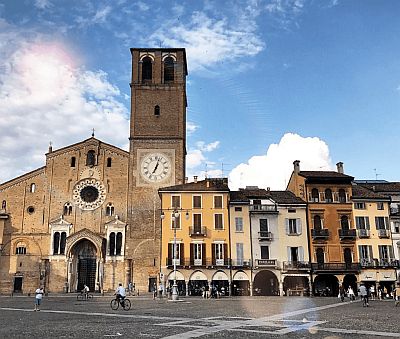Select units of measurement for the temperature and rainfall tables (metric or imperial).
Average weather, temperature, rainfall, sunshine hours

The climate of Lodi is
moderately continental, with cold, damp winters and hot, muggy summers.
The city is located in the Lombardy region, about 30 km (18 mi) southeast of Milan, on the banks of the Adda River.
Winter, from December to February, is cold, humid and dull. Temperatures can remain around 0 °C (32 °F) even during the day, especially in December and January, and the sky remains overcast for many days.
Typically, by the second half of February, the temperature tends to increase, and highs exceed quite often 10 °C (50 °F).
Fog, which in the past was fairly frequent, has become rarer in recent decades, to the point that now, it only occurs in periods when the Atlantic high pressure system dominates.
Snow in Lodi generally falls at least once every year. On average, 25 cm (12 in) of snow fall per year. In January 1985, the snow reached 75 cm (29.5 in) in height.
During
cold spells, which are becoming rarer due to global warming, the temperature can drop to -10 °C (14 °F) or below.
 Summer
Summer, from June to August, is hot and muggy, and generally sunny.
The air feels hotter because of humidity and poor ventilation, conditions typical of the Po Valley.
During
heat waves, which are becoming more frequent, the temperature can reach 35/36 °C (95/97 °F) or above.
Sometimes there may be some rainy days even in summer, or thunderstorms may break out in the afternoon or in the evening.
Best Time
The
best times to visit Lodi are spring and early summer, particularly from mid-April to mid-June. September is also a good month. However, some rainy days must be taken into account in both periods.
Summer can be very hot, although it can give some acceptable days, especially in June. You have to take into account, in summer and sometimes in May, some afternoon or evening thunderstorms.
Lodi - Climate data
In Lodi, the
average temperature of the coldest month (January) is of
2.7 °C, that of the warmest month (July) is of
24.4 °C. Here are the average temperatures.
Lodi - Average temperatures (1991-2020) |
| Month | Min | Max | Mean |
|---|
| January | -0.7 | 6.2 | 2.7 |
|---|
| February | 0.1 | 9.3 | 4.7 |
|---|
| March | 3.9 | 15.1 | 9.5 |
|---|
| April | 7.8 | 19 | 13.4 |
|---|
| May | 12.6 | 24.1 | 18.4 |
|---|
| June | 16.6 | 28.1 | 22.3 |
|---|
| July | 18.2 | 30.6 | 24.4 |
|---|
| August | 17.7 | 30.1 | 23.9 |
|---|
| September | 13.6 | 25.3 | 19.4 |
|---|
| October | 9.4 | 18.6 | 14 |
|---|
| November | 4.7 | 11.7 | 8.2 |
|---|
| December | 0.1 | 6.5 | 3.3 |
|---|
| Year | 8.7 | 18.8 | 13.7 |
|---|
amounts to
865 millimeters per year: so, it is at an intermediate level. It ranges from
60 millimeters in the driest months (January, February, July) to
95 millimeters in the wettest one (October). Here is the average precipitation.
Lodi - Average precipitation| Month | Days |
|---|
| January | 60 | 7 |
|---|
| February | 60 | 7 |
|---|
| March | 75 | 8 |
|---|
| April | 80 | 8 |
|---|
| May | 85 | 8 |
|---|
| June | 65 | 7 |
|---|
| July | 60 | 6 |
|---|
| August | 75 | 6 |
|---|
| September | 65 | 5 |
|---|
| October | 95 | 7 |
|---|
| November | 90 | 8 |
|---|
| December | 65 | 6 |
|---|
| Year | 865 | 84 |
|---|